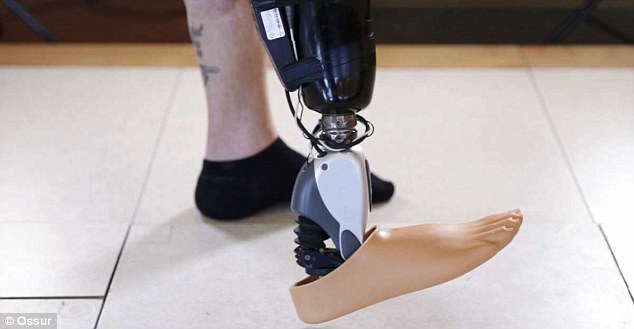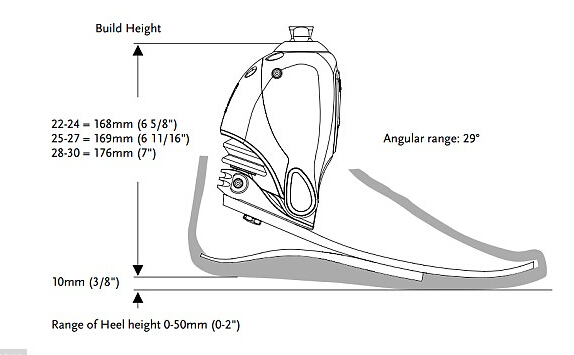
仿生腿和脚,可以通过病人的精神控制已经推出。使用植入肌肉组织传感器,截肢者已经能够成功的试验,他们失去的肢体控制。据报道,截肢者已经能够控制自己的腿,下意识地用这种方式和突破可能导致更复杂的假体在未来第一时间。
案例一,格维兹门奥拉夫松,童年的交通事件后失去了右脚和小腿年。但植入物已经使他能够控制仿生肢称为propiro英尺,重3.14lbs(1424g)。

利用微型植入式肌电传感器(IMES),分别植入残留肌肉组织上面的腿在15分钟后,他已经能够移动脚。“当我把我的脚上,我花了大约10分钟的时间来摆脱它的控制。我可以站起来走了,”他说。“我正在与我的肌肉,没有其他人这样做,脚不做它,我是这样做的,所以这真是奇怪的和压倒一切的。”当腿上的植入物,在他的小腿- 0.2英寸(毫米)长0.12英寸(3mm)宽 接收来自大脑的信号。然后这些无线传输信号到脚,告诉它要完成规定的动作,如移动踝。
“第一次,老实说,我开始哭泣。你是移动的脚踝,我基本上没有一个11年,“奥拉夫松告诉科普读物。但植入继续发送信号从大脑的仿生肢体这样,如果它被删除,它可以成为令人沮丧的不足有。奥索,它公布了今天的技术在哥本哈根的老板乔恩西古德森,说现在准备大规模临床试验。区分这从其他仿生肢体的精神控制,传感器不需要附加到特定的神经。
奥索说这个突破是使四肢可以由用户控制的更广泛的重要。他们说,即使他们的其他prprosthetic上可以升级到有这种精神控制技术。“我们的最终目标是取代失去的肢体功能,我们一直这样做的很好的一步一步的做,”公司的研发经理,thorvaldur因瓦尔森说。
原文
Amputees control bionic feet using their thoughts: Sensors inside muscles trick the brain into thinking the prosthetic is part of the body
Bionic legs and feet that can be controlled by a patient’s mind have been unveiled.
Using sensors implanted inside muscle tissue, amputees have been able to control their missing limbs in successful trials.
It is reportedly the first time amputees have been able to control their legs subconsciously in this way and the breakthrough could lead to more sophisticated prosthesis in the future.
The technology has been developed by Icelandic orthopedics company Ossur which revealed today that two patients have been trailing the technology for the past year.
One, Gudmundur Olafsson, lost his right foot and lower legs years after a childhood traffic incident.
But the implants have enabled him to control a bionic appendage called the Propiro Foot, which weighs 3.14lbs (1,424g).
Using tiny implanted myoelectric sensors (IMES), which were surgically implanted in residual muscle tissue above the leg in 15 minutes, he has been able to move the foot.
‘As soon as I put my foot on, it took me about 10 minutes to get control of it. I could stand up and just walk away,’ he said.
‘I was moving it with my muscles, there was nobody else doing it, the foot was not doing it, I was doing it, so it was really strange and overwhelming.’
When the leg is attached, the implants in his lower leg - 0.2 inches (5mm) long and 0.12 inches (3mm) wide - receive signals from the brain.
These then wirelessly transmit the signal to the foot, telling it to perform the action specified, such as moving the ankle.
‘The first time, to be honest, I started to cry. You are moving the ankle, and I basically haven't had one in 11 years,’ Mr Olafsson told Popular Science.
But the implants continue to send signals from the brain to the bionic limb so that, if it is removed, it can become ‘frustrating’ with no foot there.
Ossur, which unveiled the technology today in Copenhagen by boss Jon Sigurdsson, said it is now preparing large-scale clinical trials.
What separates this from other bionic limbs controlled by the mind is that the sensors don’t need to be attached to specific nerves.
Ossur said this breakthrough was important to making limbs that could be controlled by users more widespread.
They said that even their other current prprosthetic imbs could be upgraded to have this mind-control technology.
‘Our ultimate goal is to replace the function of the lost limb, and we've been doing so step-by-step and doing development, Thorvaldur Ingvarsson.



